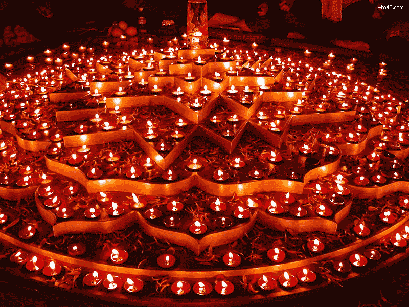Some basic cooking terms
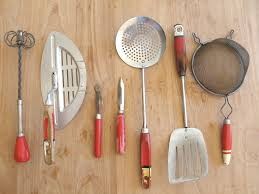 For many people cooking is one of boring chores. They feel it is slaving away over a meal, and for some cooking is complicated and complex process. Some hate it because of its routine nature and some don’t like it for it is time consuming. The fact is that cooking is a wonderful skill to have. Not only does it save your time and money on food, it can also add to better health, bring you closer to family and friends, and is certainly a great creative outlet for releasing stress. Cooking also inspiring and imaginative, you can imagine and twist styles, ingredients and look of a known dish.
For many people cooking is one of boring chores. They feel it is slaving away over a meal, and for some cooking is complicated and complex process. Some hate it because of its routine nature and some don’t like it for it is time consuming. The fact is that cooking is a wonderful skill to have. Not only does it save your time and money on food, it can also add to better health, bring you closer to family and friends, and is certainly a great creative outlet for releasing stress. Cooking also inspiring and imaginative, you can imagine and twist styles, ingredients and look of a known dish.
You don’t have to love cooking, but knowing the basics and being capable in the kitchen can open a world of opportunity to improve your quality of life. It is really refreshing and stimulating to try out newer dishes. Mastering the art of cooking some signature dishes of yours is not a bad idea. Many of us like watching the live cooking shows on television and reading about recipes in journals and magazines; there are few cooking terms which I feel we all should get accustomed to. These are those common terms which are in utilized.
 Bake: To cook on dry heat, usually in the oven. The most common baked item is bread. As far as healthy food is concerned, baked food comes first in this category because baked food items are low in fat. Baked foods are full of tastes as it cooks more within its own oil, therefore, it’s very juicy and rich in flavor if cooked with accurate time, temperature and measured ingredients. If over baked items become too dry, hard and don’t taste good.
Bake: To cook on dry heat, usually in the oven. The most common baked item is bread. As far as healthy food is concerned, baked food comes first in this category because baked food items are low in fat. Baked foods are full of tastes as it cooks more within its own oil, therefore, it’s very juicy and rich in flavor if cooked with accurate time, temperature and measured ingredients. If over baked items become too dry, hard and don’t taste good.
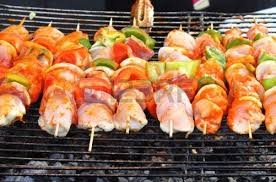 Barbecue: It refers to grilling done outdoors on charcoal or wooden fire. Barbecue takes longer time; it is a slow process of heat cooking. Barbecuing drips off fats and oils from the food. Vegetables retain more vitamins and minerals. The high heat from the grill seals moisture and keeps food tender which does not require more oil or butter in the cooking process. It reduces calories of the meat and retains vitamins in it.
Barbecue: It refers to grilling done outdoors on charcoal or wooden fire. Barbecue takes longer time; it is a slow process of heat cooking. Barbecuing drips off fats and oils from the food. Vegetables retain more vitamins and minerals. The high heat from the grill seals moisture and keeps food tender which does not require more oil or butter in the cooking process. It reduces calories of the meat and retains vitamins in it.
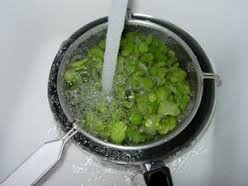 Blanch: Means immersing vegetables, fruits, and poultry in swiftly boiling water and allow it to cool slightly. Blanching vegetables is a basic technique every cook should know. Tender and crisp vegetables are briefly boiled and then plunged into ice-cold water.
Blanch: Means immersing vegetables, fruits, and poultry in swiftly boiling water and allow it to cool slightly. Blanching vegetables is a basic technique every cook should know. Tender and crisp vegetables are briefly boiled and then plunged into ice-cold water.
Caramelize: This process is to heat sugar in brown color and give it a special taste. It is one of the most important types of browning processes in foods. Caramelized sugar adds desirable color and flavor to coffee, beverages, beer and peanuts.
Clarify: To remove solids from liquids, thus making it clear. Clarified butter is unsalted butter that has the milk solids and water removed so all that remains are pure liquid golden-yellow butterfat.
 Cure: Means to preserve meat, vegetables by drying and salting. Curing is done by adding of salt, nitrates or sugar. Many curing processes also involve smoking, the process of flavoring, or cooking.
Cure: Means to preserve meat, vegetables by drying and salting. Curing is done by adding of salt, nitrates or sugar. Many curing processes also involve smoking, the process of flavoring, or cooking.
Deglaze: To dissolve thin glaze of juice and small bits on the surface of a pan in which food has been fried, sautéed or roasted. To do this, we add small amount of liquid and stir and scrape food over high heat, thereby adding flavor to the liquid for use as sauce. We do glazing in our everyday cooking after the seasoning process.
Degrease: To remove fat from the surface of stews, soups, or stock. This process is usually done by refrigerating the preparation so that fat hardens and can be easily removed.
Dice: To cut foodstuff in small cubes of uniform size and shape.
 Dredge: To sprinkle meat, poultry or vegetables with a coat of flour or other fine substance.
Dredge: To sprinkle meat, poultry or vegetables with a coat of flour or other fine substance.
Drizzle: To sprinkle drops of liquid lightly over food in a casual manner.
Dust: To sprinkle food with dry ingredients.
Fillet: is a process of removing the bones from meat or fish. A fillet is the piece of flesh after it has been boned.
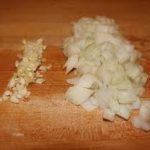 Flake: To cut lightly into small pieces for example, flakes of garlic or flakes of ginger.
Flake: To cut lightly into small pieces for example, flakes of garlic or flakes of ginger.
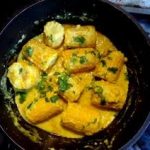 Garnish: Is to decorate a dish both to enhance its appearance and to provide a tasty foil. Parsley, lemon slices, raw vegetables, coriander, grated coconut, and other herbs are all forms of garnishes.
Garnish: Is to decorate a dish both to enhance its appearance and to provide a tasty foil. Parsley, lemon slices, raw vegetables, coriander, grated coconut, and other herbs are all forms of garnishes.
Grate: Is to rub on a grater that separates the food in various sizes of bits or shreds, coconut is grated before being cooked.
Grind: To process solids into a fine paste in the mixer or mechanically.
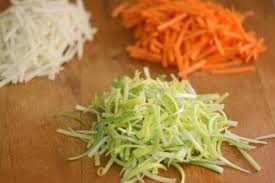 Julienne: To cut vegetables, fruits, or cheeses into thin strips.
Julienne: To cut vegetables, fruits, or cheeses into thin strips.
Knead: To work and press dough with the palms of the hands or mechanically, to develop the gluten in the flour; it is regularly done to prepare chapattis or parathas.
Lukewarm: Neither cool nor warm; approximately body temperature.
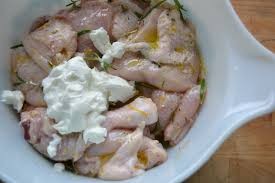 Marinate: To flavor and moisturize pieces of meat, poultry, seafood or vegetable by soaking them in specially prepared mixture. Any mixture prepared to marinate is called
Marinate: To flavor and moisturize pieces of meat, poultry, seafood or vegetable by soaking them in specially prepared mixture. Any mixture prepared to marinate is called
Mince: To cut or chop into extremely small pieces.
Pan-fry: To cook food stuff in small amounts of fat in a pan.
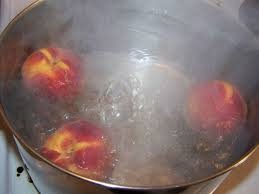 Parboil: Is a process of cooking food in boiling water for only a short amount of time to retain the color, to help preserve nutrients and to firm foods, such as vegetables. It is also used to prepare vegetables for canning or freezing and to tenderize them for further cooking processes.
Parboil: Is a process of cooking food in boiling water for only a short amount of time to retain the color, to help preserve nutrients and to firm foods, such as vegetables. It is also used to prepare vegetables for canning or freezing and to tenderize them for further cooking processes.
Pare: To remove the outermost skin of a fruit or vegetable.
Peel: To remove the peels from vegetables, fruits or meat.
Pinch: A pinch is the small quantity you can hold between your thumb and forefinger.
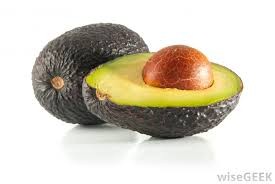 Pit: To remove pits from fruits.
Pit: To remove pits from fruits.
Planked: Means food cooked on a thick hardwood plank. When grilling is done on top of an aromatic plank or wood to cook over a heat source, the plank infuses the aroma into the food stuff as the heat is applied.
Plump: To soak dried fruits in liquid until they swell.
Poach: To cook very gently in hot liquid kept just below the boiling point.
Puree: To mash foods completely smooth by hand, by rubbing through a sieve or food mill, or by whirling in a blender or food processor.
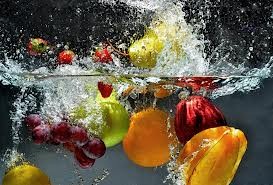 Refresh: To run cold water over food that has been parboiled and to stop further cooking process quickly to retain the color and texture of the food stuff.
Refresh: To run cold water over food that has been parboiled and to stop further cooking process quickly to retain the color and texture of the food stuff.
Render: To melt solid fat into liquid slowly.
Roast: To cook by dry heat in an oven.
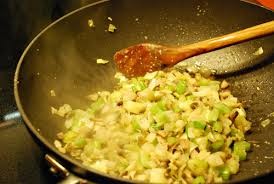 Sauté: To cook food until it changes into brown color in a small amount of oil/ghee/butter.
Sauté: To cook food until it changes into brown color in a small amount of oil/ghee/butter.
Scald: Is the process of bringing food to a temperature just below the boiling point.
Sear: To change the color of food to brown very quickly by intense heat. This method increases shrinkage but develops flavor and perks up appearance.
Shred: To cut in small, long, narrow pieces.
 Simmer: To cook slowly in liquid over low heat at a temperature of about 180°. The surface of the liquid should be barely moving, broken from time to time by slowly rising bubbles.
Simmer: To cook slowly in liquid over low heat at a temperature of about 180°. The surface of the liquid should be barely moving, broken from time to time by slowly rising bubbles.
Skim: To remove impurities, whether scum or fat, from the surface of a liquid during cooking, thereby resulting in a clear, cleaner-tasting final produce.
Steep: To extract color, flavor, or other qualities from a substance by leaving it in water just below the boiling point.
Sterilize: The process of cleaning and sanitizing jars and bottles to destroy micro organisms by boiling, dry heat, or steam. Sterilization of containers prevents contamination and lengthens the shelf life of homemade jams, pickles, juices and sauces.
Stew: To simmer slowly in a small amount of liquid for a long time.
Stir: To mix ingredients with a circular motion until well blended form of uniform consistency.
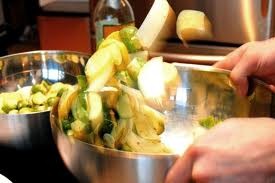 Toss: To combine ingredients with a lifting motion.
Toss: To combine ingredients with a lifting motion.
Truss: To secure poultry with string or skewers, to hold its shape while cooking.
Whip: To beat rapidly to integrate air and produce expansion, as in heavy cream or egg whites.







































